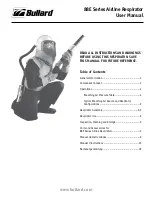
3
(Figure 7).
Installing Headband into Inner Shell
1. Turn inner shell and headband suspension upside down.
2. Place headband inside shell with brow pad facing front of
shell.
3. Insert keys into respective key slots. Push firmly until keys
snap into place. (Figure 8)
4. Insert inner shell into helmet with front of shell tilted down.
Align round hole located at front of shell with washer at
inside front of helmet. Press back of shell into helmet until it
snaps in place.
USING THE 88CS CHIN STRAP
1. Attach chin strap to inner shell by sliding chin strap loop
over hook. (Figure 9)
2. Put helmet on your head. Adjust chin strap length with the
plastic slide.
OPTIONAL LENS COVERS
1. If desired, apply optional lens covers (88VXLC), designed to
protect the respirator’s plastic lens. Apply 2-3 lens covers
at a time.
2. When lens becomes soiled, remove by pulling tab at edge
of lens cover to clear your vision.
Attaching Cape to Helmet
1. Place cape on table or workbench. (Figure 4)
2. With window frame open, place helmet on top of cape.
3. Line up the hook-shaped catch on the cape with the front
center of the helmet. (Figure 4) Catch should firmly engage
under bottom front edge of helmet.
NOTE: Installation is easiest when started at the front of
cape and helmet.
4. Ease cape rim completely into the groove along helmet
edge, working your way
to the back. Be certain cape is completely in place at every
point along helmet’s bottom edge.
5. Snap the over-center clamp to tighten cable and hold cape
snugly on helmet.
6. Close and latch window frame.
Installing Breathing Tube Assembly into
Respirator Helmet
1. Connect breathing tube assembly to helmet by screwing
plastic hose connector to fitting located on the side of the
helmet. Turn clockwise to tighten. (Figure 10) Ensure you
are using a Bullard 88VXBT. The name and part number are
stamped on the side of the breathing tube sleeve. The date
Figure 9
Figure 10
RESPIRATOR USE
of manufacture is stamped on the inside of the sleeve
�
WARNING
Do not use this respirator in poorly ventilated areas or
confined spaces such as tanks, small rooms, tunnels or
vessels unless the confined space is well ventilated, and
contaminant concentrations are below the protection
level of the respirator. In addition, follow all procedures
for confined space entry, operation and exit as defined
in applicable regulations and standards.
Donning
Before donning, make sure there is no dirt, dust or contamina-
tion inside the helmet.
1. Connect the Bullard air supply hose to the air source
supplying clean breathable air. Turn on the breathing air
source.
2. Connect breathing tube assembly to air supply hose.
Connect quick-disconnect fitting on breathing tube
assembly to quick-disconnect coupler on air supply hose.
Once fitting is secured, release coupling sleeve to lock
fittings together. Pull on both hoses to make sure they are
attached securely. Check to assure air is flowing properly
into the hood.
3. Adjust air pressure at point-of-attachment to within the
approved pressure range. See the Breathing Air Pressure
Table (page 1) for approved pressure ranges.
Check the air flow indicator/low flow alarm device
attached to the air flow control device to assure that
the indicator is reading within the green arc. Do not use
respirator if indicator reads in the red zone.
4. With air still flowing, lower 88E Series respirator helmet
onto your head for a comfortable fit.
5. Position headband for a comfortable fit. See instructions
on page 2 for proper headband sizing.
6. Pull elastic chin strap under your chin and adjust for a
secure and comfortable fit. The chin strap will help bal-
ance the helmet and should be worn at all times.
7. Be sure that the knitted inner neck cuff fits snugly around
your neck to help provide a barrier to airborne contami-
nants.
8. With breathing tube assembly attached to the helmet,
fasten belt around waist or hips and adjust for comfort.
9. Pull respirator cape around your body and secure sides by
connecting the snap hooks.
10. Recheck air pressure at the point-of-attachment and the
air flow indicator at the belt (mounted on the air flow
control device). Adjust if necessary.
11. With air still flowing into the respirator, you are now ready
to enter the work area.
Use
During use, periodically check the flow indicator at the belt to
assure that adequate air flow is being supplied to helmet.
Doffing
When finished working, leave work area wearing respirator
and with air still flowing. Once outside contami-nated area,
remove respirator and then disconnect the air supply hose
Figure 8
�
WARNING
Do not wear this respirator if any of the following conditions exist:
•You CANNOT escape without the aid of the respirator.
• Atmosphere contains less than 19.5% oxygen or is oxygen enriched.
• Work area is poorly ventilated.
• Unknown contaminants are present.
• Contaminants are in excess of regulatory requirements.
LEAVE work area immediately if:
• Any respirator component becomes damaged.
• Airflow into respirator helmet stops or slows down,
• Air pressure gauge drops below the minimum specified in the Breathing Air Pressure Table.
• Breathing becomes difficult.
• You become dizzy, nauseous, too hot, too cold or ill.
• You taste, smell or see contaminants inside the respirator helmet.
• Your vision becomes impaired.
DO NOT leave respirator in work area. Respirable dust contaminants can remain suspended in the air for more than one hour
after work activity ceases, even though you may not see them. Proper work practice requires you to wear the respirator
until you are outside the contaminated area. Failure to don, doff and store the respirator outside of the contaminated area
could result in exposure to contaminants.

























